

![]()

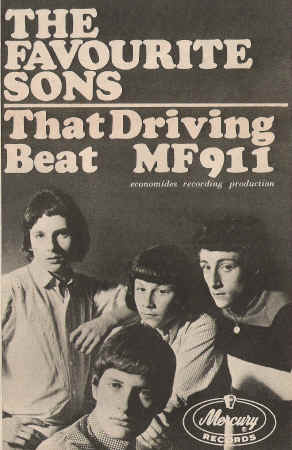
It only lasts for a paltry 98 seconds, but with a pummeling insistence that more than lives up to its title, "That Driving Beat" by The Favourite Sons perfectly encapsulates the British Mod/ R&B Scene that enjoyed its zenith during 1965-66.
But who were The Favourite Sons? Despite both sides of their single appearing on several compilations (one of them even using the A-side as the title track), the group members appeared to have been forgotten. The Beat/ Psych/ Prog Bible "Tapestry Of Delights" simply gave details of the 45 and noted that the group hailed from Hatfield in Hertfordshire. Even when the redoubtable Angel Air label issued a disc of previously unreleased recordings a few years back, the mists failed to part. The (quite famous) producer responsible for the sessions claimed that he couldn't remember much, if anything, about the group, and so sleeve-note scribe (and editor of Shindig! magazine) 'Mojo' Mills had to content himself with a brief critique of the exhumed tracks.
So you can imagine my surprise and pleasure when an e-mail thudded onto my on-line doormat recently, and the sender turned out to be the daughter of The Favourite Sons' lead singer!
Marmalade Skies are therefore very proud to present a run through of the brief, but hectic, career of Hatfield's very own The Favourite Sons, and their relations.
--------------------------------------------------------------------------------------------------------------------------------------------------------------------------------
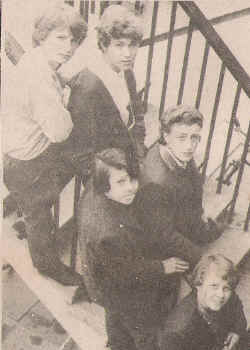 The story
starts at Burleigh School in Hatfield in 1964, where a bunch of 14/ 15 year olds
formed a group called The Juniors. Among their number were two guitarists, Alan
Shacklock and Mick Taylor, a sibling rhythm section of John (bass) and Brian
(drums) Glascock (who both took the surname Glass for their showbiz endeavours),
and a vocalist by the name of Malcolm Collins. With every Beat group in the
country being snapped up by rabid A&R men it's no surprise that The Juniors
found themselves cutting a single for Columbia. Publicity (what little there
was) put great emphasis on the extreme youth of the group members, but
"There's a Pretty Girl"/ "Pocket Size" (Columbia DB 7339)
predictably missed the charts. Equally predictably The Juniors split soon after.
The story
starts at Burleigh School in Hatfield in 1964, where a bunch of 14/ 15 year olds
formed a group called The Juniors. Among their number were two guitarists, Alan
Shacklock and Mick Taylor, a sibling rhythm section of John (bass) and Brian
(drums) Glascock (who both took the surname Glass for their showbiz endeavours),
and a vocalist by the name of Malcolm Collins. With every Beat group in the
country being snapped up by rabid A&R men it's no surprise that The Juniors
found themselves cutting a single for Columbia. Publicity (what little there
was) put great emphasis on the extreme youth of the group members, but
"There's a Pretty Girl"/ "Pocket Size" (Columbia DB 7339)
predictably missed the charts. Equally predictably The Juniors split soon after.
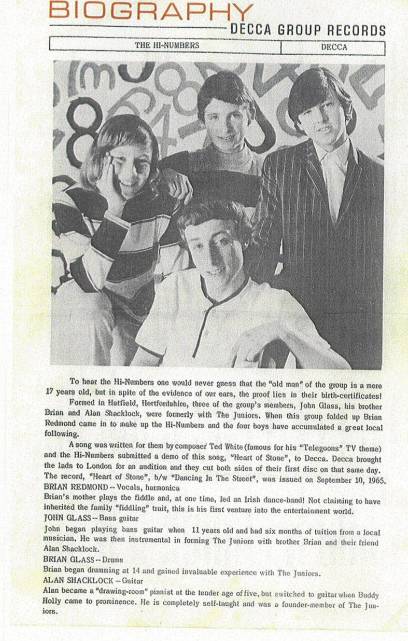 However,
Shacklock and the Glascock brothers stuck together and recruited another school
pal, Brian Redmond, as vocalist and re-named themselves The Hi-Numbers (
Townsend, Daltrey and Co changed names from The High Numbers to The Who in
November 1964 but it would be surprising if there weren't some confused
promoters at the time!) After making their debut at The Cavendish Hall in
Hatfield The Hi Numbers spent the first half of 1965 spreading their live
reputation with gigs at The Hop in Welwyn Garden City and Cooks Ferry Inn in
Edmonton, sharing bills with the likes of The Birds, The Artwoods, Steampacket
and The Who. They also recorded a demo disc featuring a song titled "Young
Blood" (unfortunately no copies survive). Mick Taylor sat in with them
occasionally, although the last time he appeared almost brought disaster when
their van caught fire outside Brian's house. Mick had to struggle out of the
window to get free!
However,
Shacklock and the Glascock brothers stuck together and recruited another school
pal, Brian Redmond, as vocalist and re-named themselves The Hi-Numbers (
Townsend, Daltrey and Co changed names from The High Numbers to The Who in
November 1964 but it would be surprising if there weren't some confused
promoters at the time!) After making their debut at The Cavendish Hall in
Hatfield The Hi Numbers spent the first half of 1965 spreading their live
reputation with gigs at The Hop in Welwyn Garden City and Cooks Ferry Inn in
Edmonton, sharing bills with the likes of The Birds, The Artwoods, Steampacket
and The Who. They also recorded a demo disc featuring a song titled "Young
Blood" (unfortunately no copies survive). Mick Taylor sat in with them
occasionally, although the last time he appeared almost brought disaster when
their van caught fire outside Brian's house. Mick had to struggle out of the
window to get free!
The Hi Numbers played at The Two I's Club in Carnaby Street where they were approached by a chap named Ted White who had a song called "Heart Of Stone". An audition for Decca was lined-up, and the group went to London where they cut "Heart Of Stone" and a cover of "Dancing In The Street". These takes were released by Decca as The Hi Numbers' first (and only) single (Decca F 12233) on 10th September 1965. They supported the record with a promotional show at the Marquee Club (fellow Decca hopeful Tom Jones was also on the bill) where they were heard by Mike Hurst, ex member of the chart topping Springfields and now an aspiring producer/ manager. Hurst was immediately impressed not only by their youthful energy but also their "elfin, Small Faces-like image".
Mike took the by now re-named The Favourite Sons to Pye Studios in Cumberland Place where they recorded eleven songs in just one afternoon. The recordings were a mixture of the group's favoured R&B and Soul covers and a few of Hurst's own compositions, which didn't really suit their style. Two of the tracks, Willie Mitchell's "That Driving Beat" and Hurst's "Walkin', Walkin' Walkin'" were earmarked for release as a single for the Mercury label. While Mike was mixing the A side an American publisher, Al Galleco, burst into the studio and demanded that Hurst sell him the publishing because he was sure that the song was going to be a hit. Mike had to refuse the deal but it was the beginning of a long working relationship between him and Galleco.
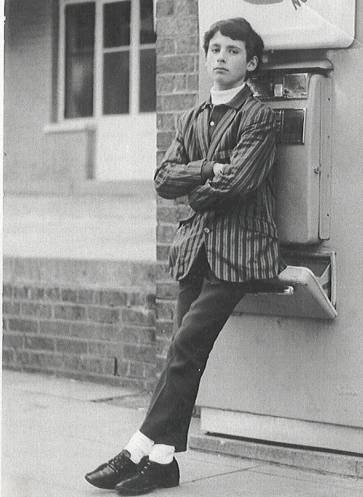 "That
Driving Beat" was released in mid-66 and duly received encouraging reviews,
but it failed to register in the charts. By now Mike Hurst was devoting his time
and energy into turning his new discovery, Cat Stevens, into a star, and
consequently no further Favourite Sons recordings were undertaken. The group
carried on gigging but on the night when they were due to play Watford Trades
Club with The Birds, Alan Shacklock, out of the blue, announced that he was
quitting. The others tried to keep the group going, and drafted in Gerry Feley
as replacement for Alan, but things weren't the same and alas, The Favourite
Sons soon split up. This though, was far from the end of the musical story for
the various group members.
"That
Driving Beat" was released in mid-66 and duly received encouraging reviews,
but it failed to register in the charts. By now Mike Hurst was devoting his time
and energy into turning his new discovery, Cat Stevens, into a star, and
consequently no further Favourite Sons recordings were undertaken. The group
carried on gigging but on the night when they were due to play Watford Trades
Club with The Birds, Alan Shacklock, out of the blue, announced that he was
quitting. The others tried to keep the group going, and drafted in Gerry Feley
as replacement for Alan, but things weren't the same and alas, The Favourite
Sons soon split up. This though, was far from the end of the musical story for
the various group members.
John and Brian Glascock teamed up once more with their old mate Mick Taylor in his new group, The Gods, alongside keyboardist Ken Hensley, but this initial line-up was short-lived as Taylor decided to join John Mayall's Bluesbreakers (by 1969 he was in an obscure Blues group from Dartford!). Ken Hensley relocated to London where he formed a new incarnation of The Gods, passing through a series of 'soon to be famous' musicians, including Greg Lake and several future Uriah Heep members, before inviting John Glascock to re-join. The Gods made two ambitious and under-rated albums for Columbia before expanding (with the return of Brian Glascock and the addition of veteran R&B vocalist Cliff Bennett) into Prog band Toefat. John Glascock later enjoyed extensive success in the mid-1970s as a member of Jethro Tull, but tragically he became ill with heart problems and died in 1979, aged just 28.
Above: Brian Redmond looking cool.
Alan Shacklock played with Chris Farlowe and The Thunderbirds, notably contributing guitar to Chris' 1968 version of "Paint It Black". Alan formed his own band "Shacklock" in 1971, changing their name to Babe Ruth in time for their debut album the following year. Babe Ruth were a popular live draw in the UK but were much more successful in other countries such as Canada, where they won gold album awards. Alan left Babe Ruth in 1975 and has subsequently enjoyed a long and varied career, details of which can be found here: http://www.alanshacklock.com/
Brian Redmond attempted to forge a career as a solo singer. He auditioned for a part in "Jesus Christ Superstar" but was beaten to it by Paul "Grandma's Party" Nicholas. Brian also recorded the song "There's Got To Be Something Better Than This" for the soundtrack of the musical "Sweet Charity" in 1969, but he lost out when Shirley MacLaine decided that she wanted to sing it. Brian quit the music business and got a 'proper' job, but he now gives help and advice to his daughter Kerry, who sings in a Rock band named The Honeythieves (www.thehoneythieves.co.uk)
As noted above, the Angel Air label released the 'lost' Favorite Sons/ Mike Hurst session recordings on an album in 2002. You can still purchase this disc at www.angelair.co.uk and if British R&B is your thing then you really shouldn't be without it. Tracklist as follows:
That Driving Beat/ Can't Judge a Book By Its Cover/ That's How Strong My Love Is/ Leavin' Here/ Lucille/ Walkin' Walkin' Walkin'/ Cry To Me/ First Look At The Purse/ Fortune Teller/ Jump Back/ No Good Without You Baby
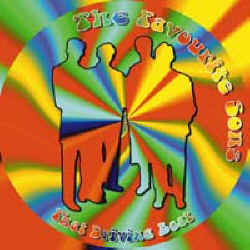
"That Driving Beat" appeared on the Past & Present label compilation of the same name in 2000, while "Walkin' Walkin' Walkin'" can be found on several collections, including "Hen's Teeth Vol 1" and "English Freakbeat Vol 3".
"Heart Of Stone" by The Hi Numbers has been included on a host of stomping R&B discs, including "Purple Pill Eaters" and "That Driving Beat Vol 2" but the easiest places to find it are undoubtedly Decca's "The Beat Scene" or "Decca Originals Vol 1". The B-side "Dancing In The Street" has yet to appear on CD (unless you know better), but was included on the 1986 See For Miles label vinyl comp "R&B Scene Vol 2".
Both sides of The Juniors' single "There's a Pretty Girl"/ "Pocket Size" resurfaced in 2000 on a French manufactured CD "Made In England # 2" (LCD 25-2).
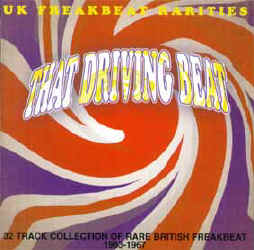

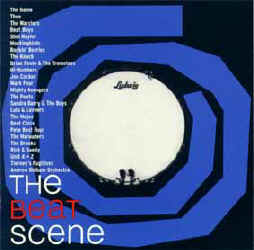
Grateful thanks to Kerry and Brian Redmond for supplying the pictures and much information.